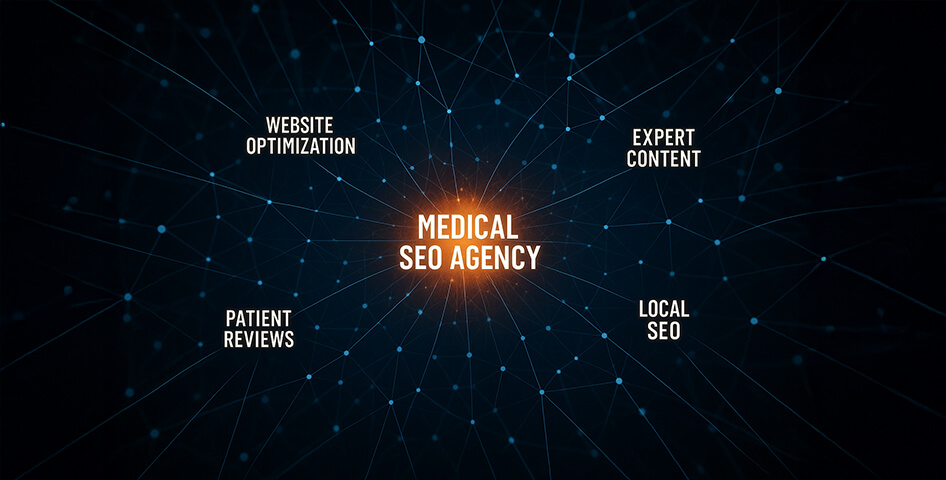The healthcare industry is on the cusp of an unprecedented digital revolution in 2025. From AI-powered diagnostics to hyper-personalized patient experiences, the pace of change is accelerating, reshaping how patients engage with providers and how services are delivered. For medspas, clinics, and any healthcare business, understanding these digital healthcare market trends isn't just about staying competitive; it's about predicting the future of patient care and positioning your practice for exponential growth.
This guide will dissect the most impactful digital healthcare market trends to watch in 2025, exploring how rapid healthcare tech adoption is fundamentally altering the industry. We'll delve into cutting-edge medtech trends and the crucial role of patient marketing data, equipping you with the insights needed to strategically adapt and dominate the evolving landscape.
The Digital Transformation of Healthcare: A New Paradigm
The shift from traditional, reactive care to proactive, patient-centric digital health is undeniable. Factors like an aging population, rising costs, and increasing patient expectations are driving rapid innovation and adoption of technology across the healthcare spectrum. For forward-thinking medical businesses, this isn't a threat but an immense opportunity.
The challenge lies in translating these broad trends into actionable strategies for your specific practice. While large hospitals might embrace AI for complex diagnostics, a medspa needs to understand how these trends translate into personalized patient marketing and seamless digital experiences.
Why These Trends Demand Your Attention:
- Patient Empowerment: Patients are more informed and demanding, expecting digital convenience and personalized care.
- Efficiency & Cost Reduction: Technology offers solutions to streamline workflows, reduce administrative burden, and optimize resource allocation.
- Data-Driven Decisions: The abundance of health data, when leveraged correctly, unlocks unprecedented insights for personalized treatment and targeted marketing.
- Competitive Advantage: Early adopters of relevant technologies will gain a significant edge in attracting and retaining patients.
Key Digital Healthcare Market Trends to Watch in 2025
1. Artificial Intelligence (AI) & Machine Learning (ML) Beyond Diagnostics
AI and ML are not just buzzwords; they are fundamentally transforming healthcare. While their role in diagnostics and drug discovery continues to expand, their impact on patient engagement and operational efficiency for practices will be profound in 2025.
- Personalized Patient Journeys: AI will enable hyper-personalized marketing messages, content recommendations, and service suggestions based on individual patient data, past behaviors, and expressed interests. This will drive higher engagement and conversion rates.
- AI-Powered Chatbots & Virtual Assistants: Expect more sophisticated AI-driven chatbots on websites and patient portals providing 24/7 immediate responses to patient inquiries, scheduling appointments, and even offering basic health information, improving patient support and reducing staff workload.
- Predictive Analytics for Patient Engagement: AI will analyze patient data to predict appointment no-shows, identify at-risk patients for follow-up, and anticipate future service needs, allowing for proactive outreach and retention strategies. This aligns with our focus on data analytics.
- Automated Administrative Tasks: AI co-pilots will assist with bureaucratic processes, documentation, and even summarizing patient visits, freeing up clinical staff to focus on patient care.
2. Telehealth & Remote Patient Monitoring (RPM) as Standard Care
Accelerated by recent global events, telehealth and RPM are solidifying their position as integral components of modern healthcare delivery.
- Hybrid Care Models: The future is not purely virtual or in-person but a seamless integration of both. Patients will expect the flexibility of virtual consultations for follow-ups, initial screenings, and mental health services, complemented by in-person visits when necessary.
- Advanced Remote Patient Monitoring (RPM): Wearable devices (smartwatches, fitness trackers, biosensors) and IoT (Internet of Medical Things) devices will provide continuous, real-time health data (heart rate, glucose, oxygen levels) allowing for proactive interventions and chronic disease management outside traditional clinical settings.
- Virtual Hospitals & Home-Based Care: Expect to see further development of "hospital-at-home" models and virtual care platforms that support complex care delivery remotely, enabled by robust connectivity.

3. Hyper-Personalized & Preventive Medicine Driven by Genomics & Wearables
The focus is shifting from treating illness to preventing it, with a strong emphasis on tailoring care to the individual.
- Genomics in Routine Care: Falling costs of genetic testing will make it more accessible, allowing healthcare providers to understand an individual's genetic predisposition to diseases and tailor preventive strategies or personalized treatment plans (e.g., pharmacogenomics for drug efficacy).
- Wearable-Driven Preventative Health: Wearable devices will move beyond fitness tracking to offer clinically relevant insights. Continuous monitoring of key health metrics will empower patients and providers with early detection capabilities, driving proactive wellness and preventive care.
- Personalized Wellness Plans: Medspas can leverage insights from wearables and patient data to offer highly personalized wellness programs, nutrition advice, and aesthetic treatment plans that go beyond surface-level concerns, embracing a holistic approach.
4. Data Interoperability & Cybersecurity: The Foundation of Trust
As healthcare digitizes, the secure and seamless exchange of patient data becomes paramount.
- Enhanced Data Interoperability: The ability to exchange health data securely and in real-time between different systems (EHRs, wearables, lab results) is becoming a prerequisite for efficient, coordinated care. New regulations will push for greater transparency and data sharing while safeguarding privacy.
- Cybersecurity Fortification: With the increasing digitization of sensitive patient information, cybersecurity will take center stage. Healthcare organizations will invest heavily in advanced security measures to protect against data breaches, which can severely damage reputation and incur massive costs.
- Privacy-First Marketing: As third-party cookies phase out, patient marketing will rely more heavily on transparent, consent-based first-party data strategies. This emphasizes patient privacy and trust, which is crucial for ethical patient marketing data collection.

5. Patient-Centric Experience & Engagement Platforms
Patient expectations are mirroring those of consumers in other industries: seamless, convenient, and highly personalized experiences.
- Omnichannel Communication: Patients expect consistent, integrated communication across all channels—website, email, SMS, social media, and in-person. This requires a unified strategy.
- Digital Health Platforms: Comprehensive platforms will increasingly connect patients, physicians, and providers, serving as a central hub for appointments, medical records, educational content, and communication.
- Gamification for Health: The integration of game-like elements into health and wellness apps can increase patient engagement, motivate healthy behaviors, and improve adherence to treatment plans.
- Accessible Design: Digital platforms will prioritize accessible design to ensure all patients, including those with disabilities, can easily access information and services. This supports broad healthcare tech adoption.

Navigating the Future: Your Strategic Response
These digital healthcare market trends represent both challenges and immense opportunities. For medspas and healthcare providers, passively observing is no longer an option. Strategic adaptation and proactive investment in relevant technologies and marketing approaches are essential for survival and growth.
At Aesthetix Media, we understand that translating these broad trends into actionable strategies for your specific medspa is complex. We are a specialized medtech marketing agency (with a core focus on medspas), built on deep industry insight, enabling us to help you:
- Identify Relevant Trends: Determine which trends offer the most impactful ROI for your practice.
- Develop Adaptive Strategies: Craft marketing and operational plans that leverage emerging technologies for patient acquisition and retention.
- Implement Cutting-Edge Solutions: From AI-powered personalization in marketing campaigns to robust data analytics, we provide the tools and expertise to execute.
- Future-Proof Your Practice: Ensure your medspa is not just keeping pace but leading the way in the evolving digital health landscape.
Don't let the future of healthcare pass your practice by. It's time to embrace innovation and leverage these digital shifts to your advantage.
Ready to strategically adapt to the digital healthcare market trends of 2025 and secure your medspa's future growth? Book a Strategy Session with Aesthetix Media today to uncover a customized plan to navigate and dominate this evolving landscape. It's time to stop reacting and start leading.
FAQ
Q1: What are the biggest digital healthcare market trends to watch in 2025?
A1: The biggest digital healthcare market trends for 2025 include widespread adoption of AI and Machine Learning for personalized patient journeys and administrative automation, the standardization of telehealth and remote patient monitoring, the rise of hyper-personalized and preventive medicine driven by genomics and wearables, enhanced data interoperability and cybersecurity, and the focus on patient-centric experience platforms.
Q2: How is healthcare tech adoption impacting patient marketing in 2025?
A2: Healthcare tech adoption is fundamentally shaping patient marketing by enabling hyper-personalization, supporting omnichannel communication, providing rich patient marketing data for targeted campaigns, and driving the need for seamless digital experiences from initial search to appointment booking. It also emphasizes privacy-first data strategies.
Q3: What are key medtech trends that medspas should monitor?
A3: Key medtech trends for medspas include advanced AI for diagnostics and personalized treatment planning, innovative wearable devices for health monitoring (which can inform aesthetic needs), virtual reality/augmented reality for training and consultations, and the integration of IoT (Internet of Medical Things) for connected devices in clinical settings.
Q4: How can patient marketing data be leveraged to drive growth in 2025?
A4: Patient marketing data can be leveraged to drive growth by enabling hyper-personalized communication and offers, predicting patient needs and behaviors (e.g., anticipating churn, identifying cross-sell opportunities), optimizing marketing spend based on ROI, and creating more effective segmented campaigns. Ethical data collection and privacy compliance are paramount.
Q5: What role will AI play in personalized patient experiences in 2025 healthcare?
A5: AI will play a central role in personalized patient experiences by powering intelligent chatbots for instant support, recommending tailored health content and aesthetic treatments based on individual profiles, optimizing appointment scheduling, and even assisting with personalized treatment plans based on genetic and lifestyle data.
Q6: How will telehealth and remote patient monitoring become standard in 2025?
A6: Telehealth and remote patient monitoring will become standard through increased adoption of hybrid care models, robust technological infrastructure (5G, IoT), and growing patient demand for convenience and continuous care. They will be integral for follow-ups, chronic disease management, and even initial consultations, especially for medspas.
Q7: What does "privacy-first marketing" mean in the context of digital healthcare market trends?
A7: "Privacy-first marketing" means prioritizing patient data privacy and security in all marketing activities, especially with the phasing out of third-party cookies and increasing regulations. It involves transparent data collection with consent, focusing on first-party data strategies, and ensuring all marketing platforms and tools are HIPAA-compliant.
Q8: How can medspas adapt to these digital healthcare market trends without overwhelming resources?
A8: Medspas can adapt by strategically prioritizing trends with the highest ROI for their specific practice, focusing on automation for efficiency, investing in scalable spa digital solutions, and partnering with specialized agencies like Aesthetix Media that can provide expert guidance and execution, alleviating the burden on internal teams.






















































